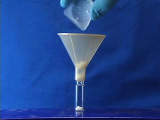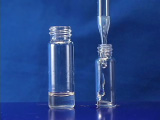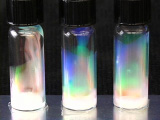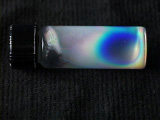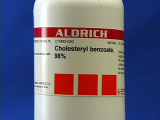
Preparation of Cholesteryl Ester Liquid Crystals
Procedure based on G. H. Brown and J. J. Wolken, Liquid Crystals and Biological Systems, Academic Press, NY, 1979, pp. 165-167 and W. Elser and R. D. Ennulat, Adv. Liq. Cryst. 2, 73 (1976).
These cholesteric-nematic liquid crystals reversibly change color as the temperature changes. One of the principal advantages of liquid crystals is their ability to map out thermal regions of different temperature. Cholesteric liquid crystals can degrade when exposed to moisture or air. As long as the mixture is stored in a sealed container it can be prepared months in advance, although the sample may need to be remelted to mix.
| Procedure | Wear eye protection |
Place 0.65 g cholesteryl oleyl carbonate, 0.25 g cholesteryl pelargonate, and 0.10 g cholesteryl benzoate in a vial. Melt the solid in a sample vial using a hair drier, heat gun, or oven. While the mixture is still liquid, divide into several vials. The product changes color as it cools. Different compositions change color over different temperature changes. Touching the vial changes the temperature and results in color changes.
Materials
Use these materials with normal chemical precautions. Solids should not be inhaled and contact with skin, eyes, or clothing should be avoided. Wash thoroughly after handling.
- Cholesteryl oleyl carbonate, Aldrich 15,115-7
- Cholesteryl pelargonate (Cholesteryl nonanoate), Aldrich C7,880-1
- Cholesteryl benzoate, Aldrich C7,580-2
- 0.01 g balance, vials, heat gun or hair dryer
| Different compositions change color over different temperature ranges. The movies above use the composition in the top row of the table. |
|
University of Wisconsin Materials Research Science and Engineering Center
Interdisciplinary Education Group | MRSEC on Nanostructured Interfaces
This page created by George Lisensky, Beloit College. Last modified June 16, 2013 .
